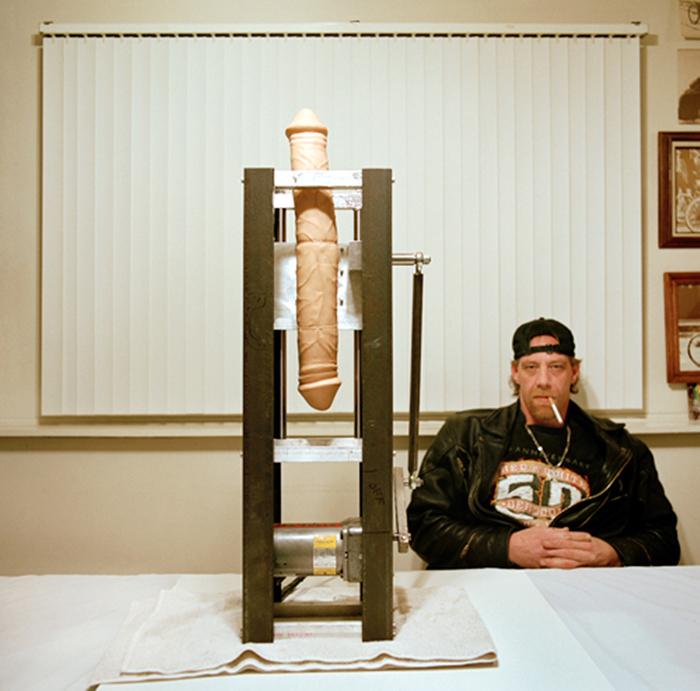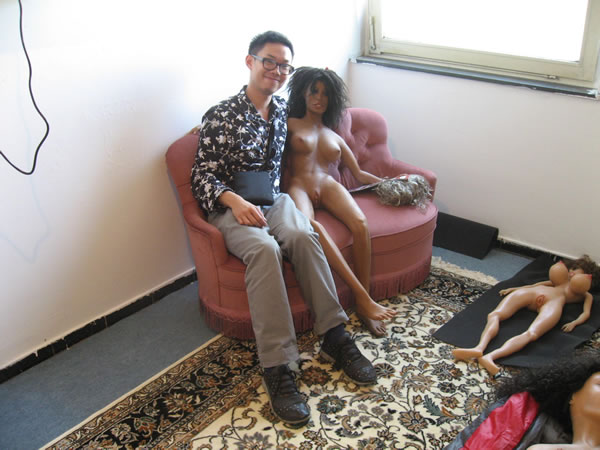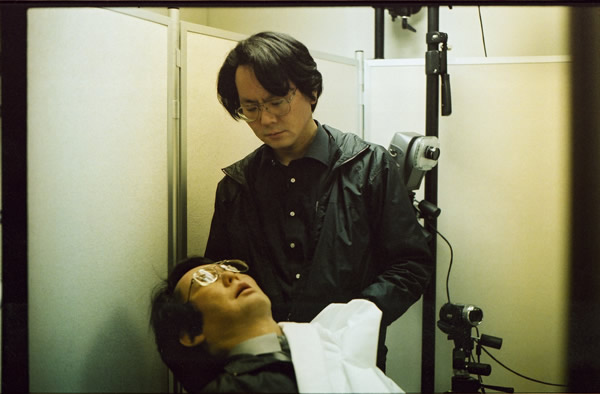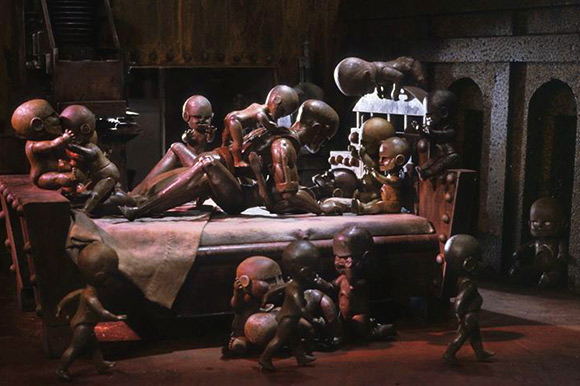 |
|||
 |
|||
 |
It does not have to be real, this is much better. Right? by Katrien Jacobs |
 |
Hong Kong sex machine researcher, Isaac Leung, has been traveling around the world interviewing designers and users of state-of-the sex dolls and devices. But rather than surveying a human yearning for affection, he found that users crave hard sex with base instruments like the gigantic USA invented “fucking machines.” These machines stem from the 1970s/1980s, and are now patented by companies like kink.com and featured on sites like fuckingmachines.com, http://dnn.thethrillhammer.com and http://buttmachines.com (for gay men) |
 |
The machines also have their lineage in the garage culture of home inventors, as revealed in Timothy Archibald’s stunning new book of photographs and interviews, Sex Machines. Archibald’s photography features gleeful bricoleurs of sex machines all over rural and suburban USA, who construct and use a variety of motorized seats, bicycles, baskets, suitcases, toolkits, and medical equipment--all with a big dildo attached. The porn movies combine a standardized steel-machine fetishism with hard-core views on the deeply aroused on the female body when penetrated by a super dildo. The newer version of fucking machines are the teledidonic type which allow male consumers to remotely control the dildo via the Internet while simultaneously chatting with a porn star. We could call this a benchmark in the scientific paradigm of human-machine collaboration. The fucking machines are an archetypal apparatus coopted and revitalized by the porn industry. They are mostly made for female porn stars who are filmed while controlling the speed of the thrusting and spinning machine, while men gaze at their intense solitary penetration and orgasm. Leung explains that the success of the movies is based on animal instinct: “Many straight men hate to see another person’s bio-cock in porn movies but they get a real kick out of seeing a woman with an artificial one.” He adds that the fucking machines are also thought to be empowering for women, who have discarded the male human actor and the male human porn director. They are still porn models but they do no longer have contact with human flesh. They deliver extraordinary hard-core female orgasms but do not need to reach closure in male ejaculation, the “money” shot. But for those of us who groove on altruistic human play and its associated sensations, Leung introduces us to the Nuremberg creator of soft synthetic humanoids at http://www.first-androids.org. The dolls are custom-made females based on specific preferences in terms of size, skin color, hair style, and genital shape. They also include temperature control, body and genital movements and respiratory movements. According the creator (who wishes to remain anonymous), they are often used by handicapped people or by the lonely and/or the fetishist. Customers arrive at his doorstep because they desire outrageous kinds of features, such as a female with more then two breasts or an entire “breast wall” or a “pussy wall” attached to their dolls. These dolls gain life and as they develop a life-style along with their owner. They confirm human sexuality as a cultivated mixture of lack and artistry. Special beds or furniture corners are built for the naked doll, who becomes hyper-domesticated while signifying a new era of social programming and responsibility. |
 |
But can we build a relationship with these dolls as long-term companions or temporary roommates? How is it that they come alive as potential lovers in our horny or needy minds? Perhaps we cannot answer this question without thinking about cinematic representations and the image world. Our imagination has conditioned by decades of pornographic representations and art. Michael Sullivan’s recent movie The Sex Life of Robots features “pornobots” or robotic looking creatures made of G.I. Joes and Barbie dolls. It is a stop-motion animation movie that became famous for being removed from Youtube.com because one of the robots had penetrated a horse’s butt. But overall it looks like a sweet miniature version of the Sadean spectacle--a female robot sits in front of her computer and has twin babies on her lap. Each of the babies is sucking one of her breasts while she scans the porn web. Sullivan explains the childish-creative impulse behind the robotic invention: “Making the movie is just like playing with dolls or playing with action figures.”.Unless we can return to this infantile habit to play with inanimate objects, our post-human lovers will be lacking in aura and warmth. Phie Ambo’s recent documentary Mechanical Love is a more thorough investigation of the human need to live with post-human beings. It features Japanese designers of robots who are involved with the idea of robotic affection. As Ambo explains; "There is a reason why the best therapeutic robots come from Japan ….Scientists in Japan are always figuring emotions into the process. What do you expect when you are with another person? What emotions are in play? Working with androids is incredibly exciting, precisely because they are something unto themselves. They're not alive, but they're not exactly dead either.” |
|
The film opens with intimate experiments by Professor Hiroshiro Ishirguro at Nogoya University. Fine-tuning his “geminoid” doll , we immediately notice an excentric individual. His robot can be controlled through the Internet and his aim is to have it increasingly look and act like himself. The point of his experiment is to present the geminoid to his wife and daughter and to table their reactions. He hopes that they will chose the geminoid over himself, and at the same time he says that he will be utterly crushed by this finding. Ishirguro wants to tackle the bigger questions: “How will the family react once you introduce an android? Will it collapse or reinvent traditional roles? What effect does the robot have on the dialogue within the family?” Again, at first sight the geminoid looks life-less, dull and certainly less funky than the scientist himself, but it is exactly the mental connection between the two beings that triggers our interest. When he finally presents the robot to his family members, it turns out that his daughter totally rejects the robot, while his wife testifies that she could get used to is. He explains that his wife does not demand that much attention in daily life either, while his daughter is very close to him and loves their daily play rituals. The other pivotal question is in the geminoid research is if Hiroshiro would be able to develop a sense of human “presence” or “aura” (what the Japanese call sonzai-kan). How do people sense a presence in interactive robots when they know there is nobody there? He explains that the geminoid is a kind of mirror but we should not be able to shift our gaze away from it. We should not be able to escape from the kind of responsive robotic gaze that he intends to develop. It is an unavoidable mirror , producing an uncanny feeling while pointing to very basic social needs. |
 |
But most of the other elderly are quite turned off by Frau Körper’s newly found love. They protest and decide to kick her squeaking seal out of the common room. Just like most owners of dolls and androids, Frau Körper is neither lucid nor demented. She is smart and aware that her attachment is transformative. She is at a stage in her life when she is used to living without sex partners or family members, and she craves something else. Her case shows that many of the most intense type of sexual play are still based on a human sense of journeying towards bliss and death. Some people surrender to a zen-like state of isolation in the process, but many will remain restless, trying to find company by means of a substitute.
|
See http://blog.wired.com/underwire/2008/12/robots-have-a-s.html |
